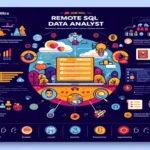Remote Manufacturing Data Analyst
Description
Frequently Asked Questions (FAQs)
What are the primary challenges a Remote Manufacturing Data Analyst faces?
One of the main challenges in this role involves maintaining precision and uniformity of data across various manufacturing sources. Since data originates from multiple systems like MES, ERP, and IoT platforms, integrating and interpreting it effectively requires substantial technical expertise. Additionally, remote collaboration with cross-functional teams demands clear communication and alignment on data-driven objectives.
How does this role contribute to improving manufacturing efficiency?
As a Manufacturing Data Analyst, you analyze production data to identify inefficiencies, forecast demand, and streamline operations. By leveraging advanced analytics tools, predictive modeling, and real-time dashboards, you help reduce waste, optimize supply chain logistics, and enhance overall productivity in manufacturing processes.
What are some industry trends that impact this role?
The rise of Industry 4.0, AI-driven automation, and digital twins significantly impact manufacturing data analytics. Companies increasingly adopt machine learning and IoT-powered data collection to enhance predictive maintenance and operational efficiency. Understanding these trends enables analysts to implement cutting-edge solutions and drive digital transformation.
What opportunities for growth are available in this position?
This role offers numerous career advancement opportunities, including specialization in AI-driven analytics, transitioning into leadership positions like Data Science Manager, or expanding expertise into industrial process optimization. Additionally, continued learning through company-sponsored training and certifications helps professionals stay ahead in the evolving field of manufacturing analytics.
How does the work environment support remote collaboration?
The organization fosters seamless remote work through collaborative digital platforms, cloud-based analytics tools, and structured communication channels. Frequent virtual meetings, shared dashboards, and real-time reporting ensure alignment between remote analysts and on-site manufacturing teams, enabling efficient decision-making and teamwork.




